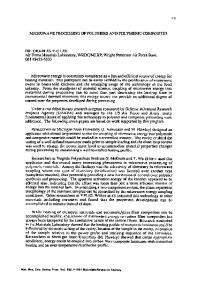Processing and Properties of Polymers Modified by Clays
- PDF / 428,073 Bytes
- 5 Pages / 612 x 783 pts Page_size
- 43 Downloads / 335 Views
Properties of Polymers Modified by Clays
Douglas L. Hunter, Karl W. Kamena, and Donald R. Paul Abstract Layered smectite nanoclays are being developed for incorporation into a variety of host polymer systems. Nanoscopic phase distribution can impart enhanced stiffness at low addition levels and improve barrier and flame-retardant properties. When combined with other inorganic and organic modifiers, nanoclays can provide synergies to generate the desired formulation properties and cost/performance characteristics. Developments with existing nanoclay products using conventional amine chemistries are described for thermoplastic, thermoset, and rubber formulations. Nanoclays are demonstrating unique, multidimensional performance and processing capabilities. Commercial applications are emerging in a variety of diverse markets ranging from automotive to packaging.
tetrahedral layers bonded to an inner alumina octahedral layer, as illustrated in Figure 2 by a molecular model of a small portion of a platelet. Other metals such as magnesium or iron can replace some of the aluminum atoms in the octahedral layer, or aluminum can replace a silicon atom in the tetrahedral layer and establish a charge deficiency. The resulting negative charge on the surface will attract any positive ions (cations), such as calcium or sodium ions, to neutralize the charge. The cations on the clay surface can be easily exchanged for other cations. A measure of this capacity is commonly referred to as the cation exchange capacity (CEC) and is usually expressed as milliequivalents of cations per 100 g of clay. It should be understood that each montmorillonite deposit found in nature is unique. Particle size, shape, and charge are different, and the replacement elements and positioning in either the octahedral or tetrahedral layers can have a significant effect on the characteristics and performance of the specific montmorillonite. Also, the impurities composing the overall bentonite deposit can be very different; removing non-montmorillonite impurities is essential to the overall performance of
Nanoclays and Host Polymers “Nanoclay” is a term often used when referring to a clay mineral with a phyllosilicate or sheet structure having dimensions on the order of 1 nm in thickness. The mineral base can be natural or synthetic and is hydrophilic. The clay surfaces can be modified with specific chemistries to render them organophilic and therefore compatible with organic polymers. When small quantities are added to a host polymer, the resulting product is often termed a clay– polymer nanocomposite.1–5 Host polymers can be thermoplastic or thermoset, commodity or engineering/ specialty plastics, crystalline or amorphous. Nanocomposite preparation can be done at the monomer stage by using in situ polymerization (e.g., polyamides and thermosets), by solution-blending organoclays with polymers, by mixing polymer latices with aqueous suspensions of unmodified clays, and finally by melt-compounding organoclays with thermoplastics.
Nanoclay Sources, Structur
Data Loading...











